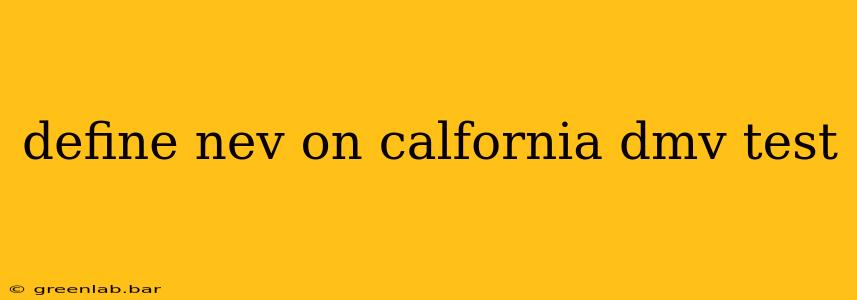The California DMV test often presents abbreviations and terms that can be confusing for prospective drivers. One such term is "NEV," which stands for Neighborhood Electric Vehicle. Understanding what an NEV is and its limitations is crucial for passing the written and, potentially, the driving portion of the California DMV test. This guide will break down everything you need to know about NEVs in the context of the California DMV exam.
What is a Neighborhood Electric Vehicle (NEV)?
A Neighborhood Electric Vehicle is a low-speed electric vehicle designed for short-distance travel within residential areas and other designated low-speed zones. Think of them as a step up from golf carts, but with more robust safety features and capabilities. Key characteristics of NEVs include:
- Low Speed: NEVs typically have a top speed of 25 mph or less. This significantly limits their use on major roads and highways.
- Electric Power: They are powered solely by electricity, offering a quiet and environmentally friendly driving experience.
- Limited Range: NEVs generally have a smaller range than standard electric vehicles, requiring more frequent charging.
- Specific Operational Regulations: NEVs are subject to specific regulations regarding where they can be operated, often restricted to streets with speed limits of 35 mph or less.
NEV Regulations and the California DMV Test
The California DMV test will assess your knowledge of NEV regulations, including:
- Speed Limits: You'll need to know the speed limitations for NEVs and understand the consequences of exceeding those limits.
- Road Usage Restrictions: The DMV test will cover where NEVs are permitted and prohibited. Highways and freeways are typically off-limits.
- Safety Equipment: You should be aware of the required safety features on NEVs, such as headlights, taillights, and turn signals.
- Licensing Requirements: While the specific licensing requirements may vary depending on the type of NEV and your age, understanding the general licensing needs for operating an NEV is crucial for the test.
- Right-of-Way Rules: NEVs must follow the same right-of-way rules as other vehicles.
Common NEV Test Questions (Examples):
While the exact questions vary, expect questions focusing on these key areas:
- Can an NEV be operated on a freeway? (Answer: No)
- What is the maximum speed limit for an NEV? (Answer: Typically 25 mph or less)
- What safety equipment is required on an NEV? (Answer: Headlights, taillights, turn signals, etc.)
- Are there specific licensing requirements for operating an NEV? (Answer: Yes, often different from standard driver's licenses)
Preparing for the NEV Portion of the California DMV Test
Thoroughly reviewing the California DMV handbook is essential for success. Pay particular attention to the sections on low-speed vehicles and neighborhood electric vehicles. Practice using online DMV practice tests to familiarize yourself with the question formats and types of information tested.
By understanding the specific regulations and limitations of NEVs in California, you'll significantly improve your chances of passing the DMV written test. Remember to always consult the official California DMV handbook for the most up-to-date and accurate information.

